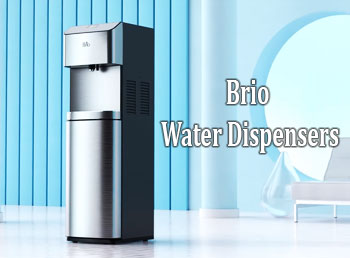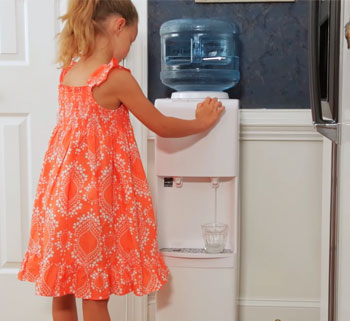Water dispensers provide convenient access to filtered water for homes and offices. Two popular brands are Brio and Primo. But which one is the better choice?
This comprehensive guide compares the key features, pros and cons of Brio and Primo water dispensers to help you decide.
A Brief Comparison Table
| Feature | Brio | Primo |
| Types | Bottom load, top load | Bottom load, top load |
| Filtration | Carbon, ion exchange resin | Carbon, reverse osmosis |
| Temperature Settings | Hot, cold, room temp | Hot, cold, room temp |
| Capacity | 3-5 gallons | 3-5 gallons |
| Dispenser Styles | Modern, traditional | Modern, traditional |
| Certifications | ENERGY STAR, NSF | ENERGY STAR, NSF |
| Warranty | 1 year | 1 year |
| Price | $$ | $$$ |
| Ease of Use | Simple controls | Simple controls |
| Maintenance | Filter changes | Filter changes |
Overview of Brio Water Dispensers
Brio water dispensers offer sleek and efficient water filtration for homes and offices. They come in both bottom load and top load models to suit different needs.

Some key features of Brio water dispensers include:
- Modern and traditional styling – Brio dispensers come in stylish designs like tempered glass and stainless steel to fit any decor. Traditional styles are also available.
- Hot, cold, and room temperature water – Dispenses steaming hot water for beverages, chilled water for drinking, and unheated water.
- Large 3-5 gallon capacity – Holds enough water so refills are less frequent.
- Carbon and ion exchange filtration – Removes impurities, chemicals, bad tastes and odors from tap water.
- Energy efficient operation – ENERGY STAR certified models consume less electricity.
- Simple controls – Easy to use electronic buttons or toggles for dispensing water.
- 1 year limited warranty – Covers defects in materials and workmanship.
- Optional extras – Upgrades like nightlights, drip trays, or self-sanitizing features are available.
- BPA-free materials – Models feature BPA-free plastic water tanks.
Brio water dispensers provide high quality filtration and modern conveniences at an affordable price point. They are easy to set up, maintain, and use.
Also Read: Differences Between Storm Bottom And AquaBarista.
Overview of Primo Water Dispensers
Primo water dispensers are premium models known for advanced filtration and innovative features. They are available as bottom load or top load units.
Key features of Primo water dispensers:
- Sleek modern styling – Primo dispensers have an elegant and ultra-modern high-tech look.
- Reverse osmosis filtration – Advanced multi-stage RO filtration removes more contaminants than basic carbon filters.
- UV sanitization – Ultraviolet light helps kill bacteria in the dispenser’s reservoir.
- Hot, cold, and room temperature water – Dispenses water at just the right temperature.
- Nightlight – Convenient light illuminates water spout at night.
- Self-sanitizing option – Automatically cleans the nozzle to inhibit bacteria growth.
- 3-5 gallon capacity – Holds enough water for most family or office needs.
- Leak prevention – Sensors detect leaks and shut off water flow to prevent messes.
- ENERGY STAR models – Eco-friendly units use less energy than standard models.
- 1 year warranty – Covers defects in materials or workmanship.
- Premium price – Primo dispensers cost more than average models but provide superior quality and features.
For those wanting the cleanest, most purified water along with high-end features, a Primo water dispenser is a smart choice despite the higher price.
Also Read: Comparison Between Leaf Home Water And Culligan
Detailed Comparison Between Brio and Primo
Let’s go in-depth to compare the key differences between Brio and Primo water dispensers across various factors:

Filtration System
- Brio water dispensers use a combination of carbon block filtration and ion exchange resin to remove particulates, chlorine, metals, and other impurities from tap water. This produces cleaner, better tasting water.
- Primo dispensers utilize multi-stage reverse osmosis filtration. RO filtration forces water through membranes to remove contaminants as small as 1 micron. This more extensive filtration results in purer water than carbon filters can produce.
- An advantage of Brio is that its filters tend to have a longer lifespan before needing replacement compared to RO filters.
- Primo’s RO filtration removes more impurities and is better for areas with poor water quality. But the tradeoff is higher filter costs over time.
Convenience Features
- Both brands offer the standard hot, cold, and room temperature water temperature settings.
- Nightlights on the dispensing spout come standard on all Primo models but are only optional addons for Brio dispensers.
- Self-sanitizing dispenser nozzles that automatically clean themselves are included on some higher-end Primo units but not available for Brio.
- Entry level Brio dispensers tend to have more basic controls like buttons or flip switches compared to Primo’s digital touchscreens and electronic controls.
- Primo dispensers with leak prevention sensors that detect and shut off leaks provide an extra convenience not found on Brio models.
Design & Styling
- Brio dispensers come in both modern, elegant designs as well as traditional styles to match any decor.
- Primo focuses more on contemporary, cutting-edge styles with accents like metal trim and LED lighting that look great in modern kitchens.
- Brio offers a wider variety of color options and finishes like black, white, stainless steel, and brushed nickel.
- Primo typically has a more uniform look across models in popular finishes like glossy black or stainless steel.
Capacity
- Both brands offer standard 3-5 gallon reservoir capacity on most models, which is suitable for average family and office needs.
- Larger 8-10 gallon models are also available from Brio and Primo for high demand settings.
- Primo’s reserves may need more frequent refilling due to water loss from RO filtration.
Certifications
- Top models from both brands meet ENERGY STAR standards for energy efficiency and savings.
- Brio and Primo dispensers are both NSF certified to guarantee the filtration systems meet standards for safety and contaminant reduction.
Warranty
- Both Brio and Primo provide a 1 year limited warranty covering defects in materials and workmanship.
- Optional extended warranties up to 3 years are available for either brand at added cost.
Pricing
- Brio dispensers range from $200 to $600 for most models, making them an affordable mid-range option.
- Primo’s superior filtration and tech features place models in the premium price range from $400 to over $1000.
- Primo dispensers carry higher long-term costs due to more expensive replacement filters.
Ease of Use
- Both brands are designed for simplicity with easy push button controls or toggle levers for hot, cold, and room temperature water.
- Higher end Primo models include more advanced touchscreens and electronic interfaces. But basic models have similar simple controls as Brio units.
- Primo’s leak prevention sensors add convenience by automatically stopping water flow from leaks or overflows.
Maintenance
- Routine maintenance is straightforward for both brands – changing filters and sanitizing the reservoir periodically.
- Brio’s carbon block filters tend to have a longer lifespan (6-12 months) before needing replacement compared to Primo’s RO filters.
- Primo’s UV sanitization and self-cleaning nozzles reduce manual cleaning needed for the reservoir and faucet.
Also Watch This Review Video:
Frequently Asked Questions (FAQs)
Primo water dispensers edge out Brio when it comes to filtration capabilities and high-end features. Primo’s advanced reverse osmosis system removes more contaminants for better tasting, ultra-pure water. Models with UV sanitizers, self-cleaning nozzles, and leak prevention also add convenience. But Primo’s superior performance comes at a higher price point. Brio dispensers offer very good carbon filtration at a more affordable cost. Brio is a great choice for budget-minded buyers looking for clean, filtered water with modern style and simple controls.
For most homes and offices, Brio and Primo dispensers both provide excellent filtered water from leading brands. Primo is the best option if your top priority is removing the most contaminants through reverse osmosis filtration. Brio is likely the best choice if you want modern style and solid carbon filtration at a more modest price point.
Yes, Primo water coolers are extremely high quality and outperform most competing brands. Primo’s multi-stage reverse osmosis filtration system filters water more thoroughly to remove impurities, chlorine, chemicals, and microorganisms. Useful extras like UV sanitizers, self-cleaning nozzles, and leak detectors add convenience. Primo dispensers also have beautiful modern styling. The only downside is the higher cost, but Primo water coolers are certainly among the best available.
Primo water dispensers are manufactured by Primo Water Corporation, based in Winston-Salem, North Carolina. The company was founded in 2004 and has grown into one of the largest bottled water and water dispenser providers in the United States and Canada. In addition to residential water dispensers, Primo also produces water bottles and dispensers for businesses, water refill stations, and other water filtration products. The company has a reputation for high quality standards and innovative design in their water dispensers and other products.
Also Read: Comparison Between Primo Water And Culligan Water
Final Thoughts
When choosing between Brio and Primo water dispensers, consider your priorities. Those wanting the cleanest water will appreciate Primo’s reverse osmosis filtration, while Brio provides impressive carbon filtration at a more wallet-friendly cost.
Both brands offer modern style and make obtaining filtered water convenient for homes and workplaces. Carefully weigh the pros and cons of both dispensers to decide the best option for your needs and budget.
With high-quality construction and carefree maintenance, Brio and Primo dispensers can keep you hydrated with refreshingly pure water for years to come.

